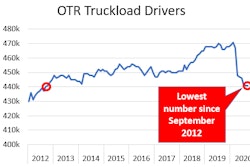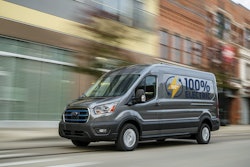
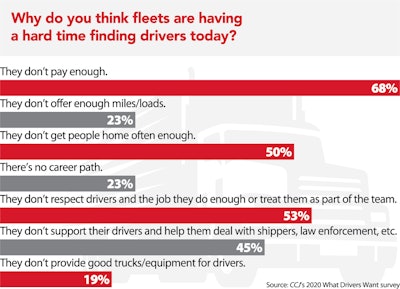
What Drivers Want
Glean valuable insights from CCJ Surveys to find out what drivers want from your fleet.
In the full survey, you’ll see what drivers think about:
- Pay (what they are getting
and want to get) - Why they switch fleets
- Family life and home time
- Miles/Loads
- Equipment and truck features
The coronavirus pandemic battered just about every business segment imaginable for at least some period of time this year, but the trucking industry fared better than many.
Trucking lost almost 100,000 jobs as COVID-19 and ensuing lockdown orders and a soaring national unemployment rate sapped consumer spending. Trucking employment has rebounded every month since April, but still has not reached pre-pandemic levels. Drivers responding to CCJ’s 2020 What Drivers Want survey – those who remained behind the wheel throughout the outbreak – expect to bring home about the same amount of money as the previous year.
Only 33% of respondents expected to bring home less pay than 2019. The majority (42%) expected to make the same money, while 25% expected to make more. Leased owner-operators were the largest group expecting to take a pay cut, with 45% reporting that based on their number of miles and loads so far this year that they expect to make less money this year than last.
“The only reason I’ll make more this year is because COVID has kept fuel prices low,” said Monroe, Georgia-based leased owner-operator James Schiebrel.
A driver for more than 20 years, Transportation Services Unlimited driver Roy Shultz expects hauling industrial-strength bleach will put more money in his pocket by year’s end as demand for virus-fighting chemicals remains steady.
Other COVID-related hauls also have kept miles up.
“My dedicated runs are food and food precursors, so our routes actually became more stable and reliable with COVID-19,” said Dart Express driver James Duff, a trucking veteran of more than two decades.
Despite the lack of a tested playbook on how companies should respond to a pandemic, the majority of survey respondents were pleased with corporate reaction. Nearly 60% of all drivers said their company did everything they reasonably could to keep drivers making money on the road and safe from the virus. Only 17% felt the response was poor. The balance, 24%, felt the company shared basic information, updates and/or personal protective equipment (PPE), but otherwise little changed day-to-day.
“Fair is good for me,” said Alexandria Perkins, a regional company driver for Wiley Sanders. “Life was blessedly normal at the yard.”
Cassandra Chotiner, a driver for Nick Strimbu, said the Ohio-based carrier provided handmade masks, hand sanitizer, gloves and cleaning kits for all the drivers’ trucks, “and changed policies to where our shop has to sanitize after being in our trucks and no one else can use our trucks. If we’re on vacation and a driver’s truck breaks down, they have to wait, or they’re put into a rental to keep our germs to ourselves. My company is doing an excellent job, in my opinion.”
Paying the bills
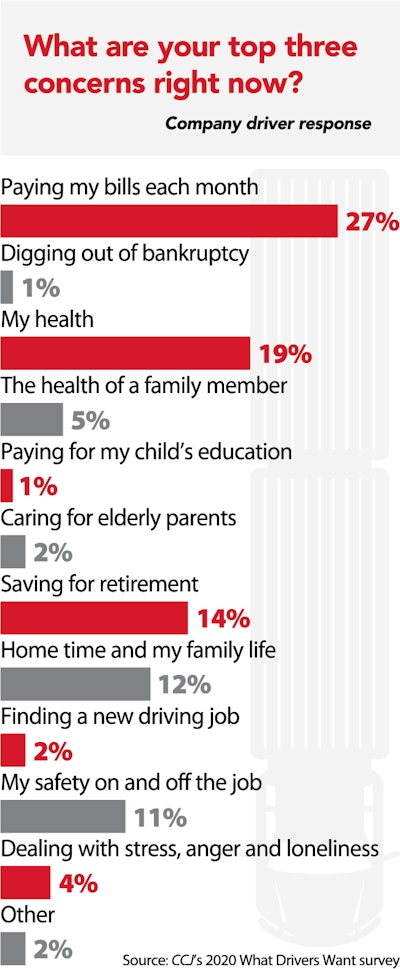
Only 5% of surveyed company drivers laid claim to earning six figures in 2019, and the drivers who earned $75,001 to $100,000 was mostly unchanged from the prior year at 24%. The $50,001-to-$75,000 bracket reached 47% last year, up from 45% in 2018. The number of drivers earning $35,001 to $50,000 shrank 3% — down from 20% in 2018 to 17% last year, and drivers who earned $35,000 or less dropped from 6% in 2018 to 5% in 2019.
Despite relatively stable wages year over year, survey respondents noted that paying monthly bills was their top concern (28%) for the second consecutive year.
“The industry needs minimum weekly pay standards, not just mileage-based,” said Cardinal Logistics driver Barry Robinson.
Money-related woes were two of drivers’ top three concerns: No. 2 was their health (19%), and third (14%) was saving for retirement. Home time and family life (13%) was a close fourth, and safety on the job (11%) rounded out the top five.
“All aspects in life are extremely important from the finances as the way to provide for your family and your home life,” Shultz said. “I used to drive over the road and never saw the house for five weeks at a time. I will flip hamburgers first before I would ever do that again.”
With so much personal stress fueled by the lack of home time and irregular pay, drivers unsurprisingly rank both issues as two of the top three reasons carriers have a hard time finding and keeping drivers. Almost 70% of respondents said fleets don’t offer enough pay, and 50% said carriers don’t allow enough home time. A lack of respect and support for drivers once they’re out on the road was cited by 98% of responding drivers.
Perkins, whose been driving for less than 10 years, said many companies don’t work toward making drivers feel like a member of the team, rather treating them like “just a means to an end.”
Drivers also noted that a lack of respect extends beyond the fleet level, but having an employer’s support once they leave the yard goes a long way.
“We put our life, health, body, family on the line daily to get this country moving, yet we are treated like third-class people where we are not even allowed to use the restroom when we get to our destination,” said Landstar leased owner-operator Donnette Williams. “We bring your merchandise so you can keep your company going, yet your restrooms are for employees only.”
Mo’ money (and respect), fewer problems
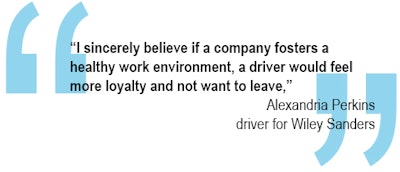
Additional pay (33%) tops the list of reasons respondents would consider changing jobs and driving for another fleet. Offering drivers their choice of routes and hauls (21%) was a distant second, and showing drivers appreciation and developing a team atmosphere (19%) is a close third.
“I sincerely believe if a company fosters a healthy work environment, a driver would feel more loyalty and not want to leave,” Perkins said.
While drivers can be swayed by larger payouts, how they receive it matters. Only 2% of respondents said they would consider changing carriers for “a big sign-on bonus,” the same amount that said they would make the switch for a newer truck.
“Just need a good truck to do my job safely,” said Southeastern Freight Lines driver Jeremy Wilson.
“I don’t care about the brand of truck I drive,” added Thomas Kirkpatrick, a driver for Leggett and Platt. “As long as it’s clean and mechanically sound, I’m happy.”

“Automatic transmissions have no advantage over a good driver’s ability to drive and shift,” said ABF driver Mike Boyd.
Piling on technology also isn’t attractive to drivers being wooed by a new carrier. More than half (53%) said they expect new tech to make it easier for fleets to monitor and control drivers, and another 28% think new technology will make trucks easier to drive, which will cause pay to go down.
Given the opportunity to be in charge of their own fleet and implement one change, 27% of respondents said they would raise pay to attract and retain drivers. Another 18% said they would offer guaranteed minimum pay or mileage/loads, and 14% said they would offer excellent health benefits and a 401(k) retirement plan.
“It’s not one thing that matters,” added Mid Age Transport driver Bret Hatch. “It’s a combination, like health insurance and a minimum pay each week. That insurance is useless if you can’t pay your bills.”
Hanging in there
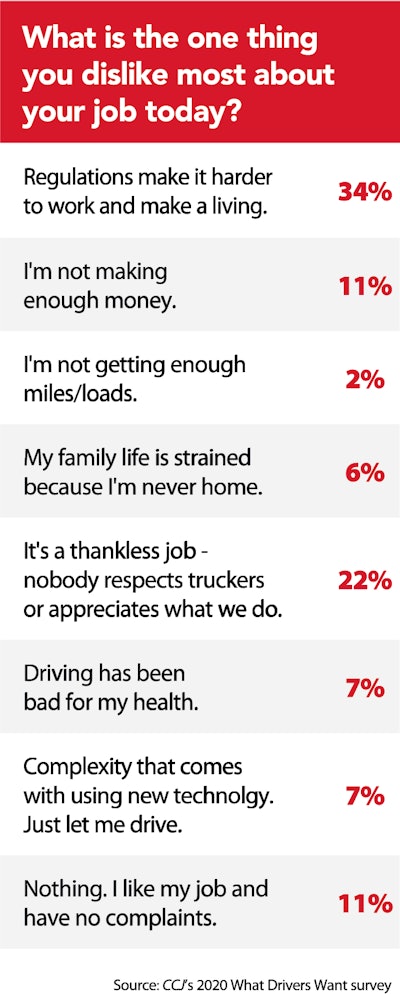
Despite dissatisfaction with pay, the vast majority of survey respondents plan to tough it out, as 93% rated their long-term prospects of driving a truck as “Good” or “Fair.” Only 7% noted the need to find another job.
“This job is all about respect and give and take,” said Crete driver Charlie White. “Some weeks are great, others okay and then the crappy week. And you got to roll with it.”
The majority of respondents (44%) were happy driving for a fleet as long as their pay increased annually, but 22% would like to leave the industry entirely. The same number (14%) would either like to stay in the industry but in a non-driving role, or buy their own truck and become an owner-operator.
More than half (55%) aren’t yet sure when they plan to retire, while 7% plan to sunset their careers within the next year. Among those with no plans to retire, 40% said it’s because they like their job, and another 37% said it was because they needed the money.
Half of the company driver respondents said they had a retirement package through their employer, but money is also a consideration in postponing retirement, as 66% of all drivers surveyed said they hadn’t saved enough money to retire.
The need for more money and increased pay was a clear theme through the annual survey, but it wasn’t the No. 1 reason drivers cited for what they dislike most about their job. That honor lies with the government, as 34% said that regulations make it harder to work and make a living. A lack of respect comes in at No. 2 with 22%, and 11% cited not making enough money, the same percentage as the number of drivers who said they liked their job and had no complaints.



